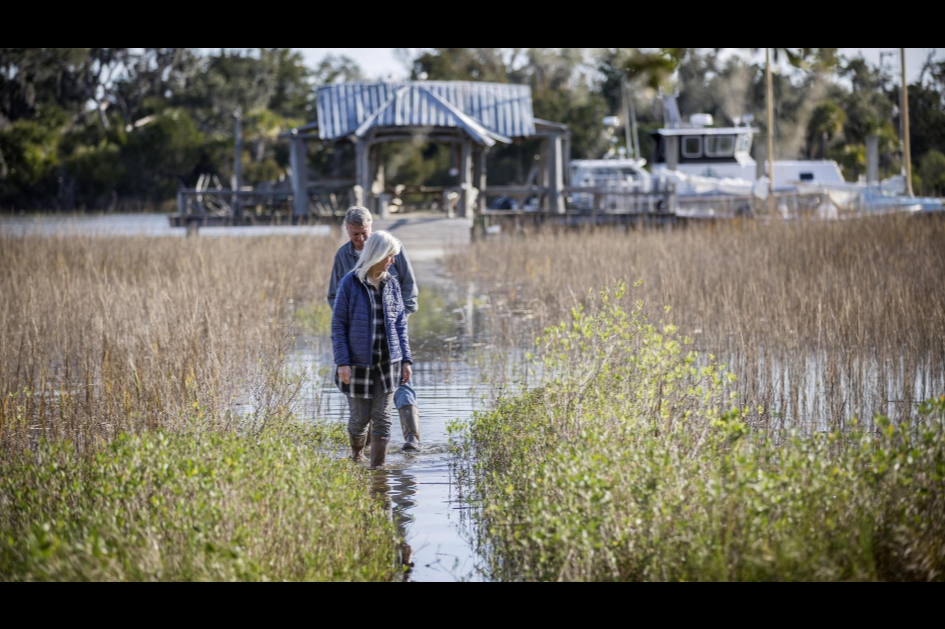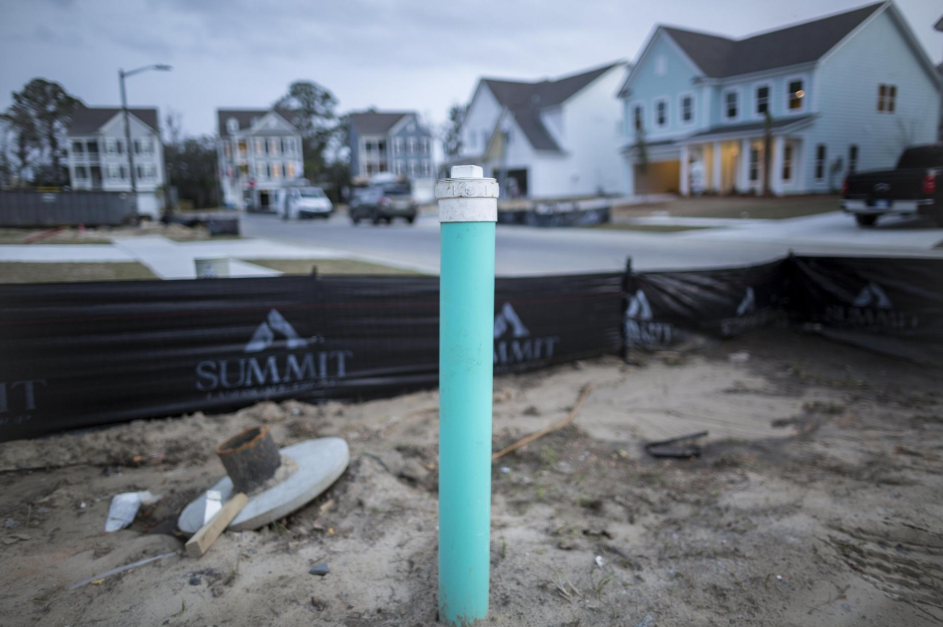Wanda and David Scott fell in love with their Whitemarsh Island property separately more than three decades ago, each finding the charming 1938 marsh-front home on their own and rushing to tell the other of their discovery. They bought the house and moved here from Liberty County. The couple raised their three boys here, and now it’s where they continue to operate their marine survey business.
As they walk out to their dock on a warm winter morning, it’s clear how in sync they are, not just with each other but with also this property on Richardson Creek.
Their shoes crunch on the dock’s causeway, an old-fashioned access grandfathered in from a time before the state enacted marsh regulations.
It’s a feature that makes the couple even more in touch than most coastal Georgians with how the water has been creeping up over the years. They plan dock parties around the tides so guests won’t get their feet wet. Lately the usual handful of impassable times turned to a long stretch.
“We had king tides and we had 75 days where every day this was flooded,” David said. “Seventy-five days in a row on high tides.”
And they have concerns that go deeper. Literally. Septic systems lie under the neighborhood yards, including the Scotts’. Halfway along her gravel walkway out to their dock, Wanda turned to look at their backyard, green with winter rye grass.
“It seems it makes sense to me that if septic is this close to the marsh and the marsh floods at high tide more regularly now, then ... a part of the septic is (in the) outflow.”
Septic, septic everywhere
The integrity of septic in the face of sea level rise is not just a concern for Whitemarsh Island. In Georgia’s six coastal counties, state officials have identified almost 60,000 septic systems, both disused and active.
Over the last decade, University of Georgia Marine Extension and Georgia Sea Grant compiled a comprehensive, electronic inventory of these septic systems to help locate and manage failing systems that threaten water quality. The publicly available inventory, called Welstrom, also serves as a resource for understanding private wastewater infrastructure.
Chatham County has the most coastal septic with over 12,000 documented, but these systems blanket the coast, servicing everything from mobile homes to mansions. On tony ocean-front Sea Island, 97 septic systems serve what real estate database Zillow reports is the highest priced zip code in Georgia, boasting a median home price of $2.4 million. Some of these tanks and drain fields are just steps from the beach.
How climate change threatens to overflow toilets
Septic systems send a household’s waste water — from the sinks, toilets, showers, the washing machine and dishwasher — into a buried water-tight tank in the yard. There the solids settle and the liquid wastewater flows into a nearby drain field where soil microbes treat it as it percolates through, ultimately discharging to groundwater or rivers and streams if they’re close by.
“To function adequately, you have to maintain a certain level of separation between the septic drain field and the groundwater table so that the effluent flowing to the drain field has space to percolate through the soil and be treated by all the microbes in there,” said Scott Pippin, a faculty member with the University of Georgia’s Carl Vinson Institute of Government.
As climate change accelerates sea level rise, the groundwater is rising, too, along the coast. Global sea level has risen by about 8 inches since reliable record keeping began in 1880, according to the Fourth National Climate Assessment Report. It is projected to rise another 1 to 4 feet by the year 2100.
That means coastal septic systems are getting squeezed. Especially vulnerable are the drain fields, which require a few feet of dry soil separating them from the water table to filter pollutants.
“And as the groundwater table rises, that separation is going to be limited,” Pippin said. “So the first impact is going to be less treatment of the effluent that comes out of the septic systems. So that’s going to translate potentially into pollution transmitted to drinking water wells and other water resources that are nearby, but also into surface waters and wetlands and streams and beaches and places like where people might encounter it and have public health impacts.”
Sewers vs. better septic
There are solutions. Septic can work well to manage wastewater. It can be improved where sea level rise is encroaching on it. And sewer lines can be brought in where appropriate.
But coastal residents first have to recognize the problem, as some already have.
Wanda Scott noted where neighbors had improved their septic. A mound of earth in one front yard raises that drainage field a few feet above the high water, giving more room for filtering. It’s a solution more coastal counties are turning to.
She also pointed out a new development called Turner’s Pointe in the southeast part of the neighborhood. No septic there.
“In order to develop that property, the developer had to tap into the sewage lift station and that’s on the other side of Highway 80,” she said.
That’s another solution, though sewerage is also susceptible to the effects of sea level rise.
“Failing septic system is a relatively discrete source of pollution, but a cracked sewer pipe can be a much larger scale,” Pippin said. “So they’re rarer, but they’re bigger. And so it’s a trade-off of risk that you’re taking on.”
Nearby Wilmington Island saw the downside of that trade before Christmas when heavy rains overflowed a sanitary sewer, causing a major sewage spill of 60,000 gallons about a third of a mile from the Wilmington River.
The Scotts and their neighbors view Richardson Creek as their backyard playground, a place to crab and fish, even a gathering place. Every Fourth of July they jump off a nearby bridge together and enjoy a group float. The thought of human waste in the water appalls. They’ve been organizing to do regular water testing before it becomes a problem they can see or smell.
And it can get to that, said Jason Evans, interim director for the Institute for Water and Environmental Resilience at Stetson University in DeLand, Florida. Evans worked on a climate resilience plan for Tybee when he was at UGA. Now in Florida he’s seen that state’s septic problems flow into local waterways, like in Oak Hill, Florida.
“I was just out there about six months ago and I was in this canal,” he said. “And you could actually smell the human waste because of the failing septic tanks. And so that’s a really extreme situation there.”



